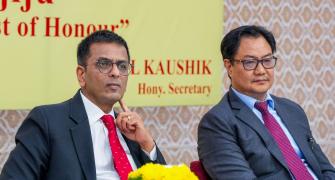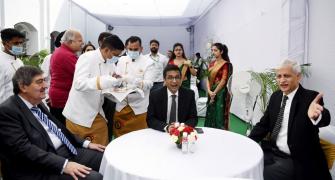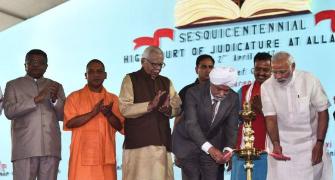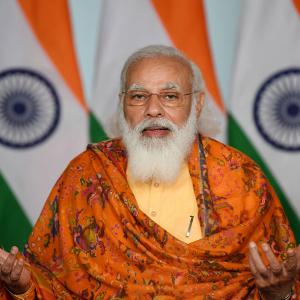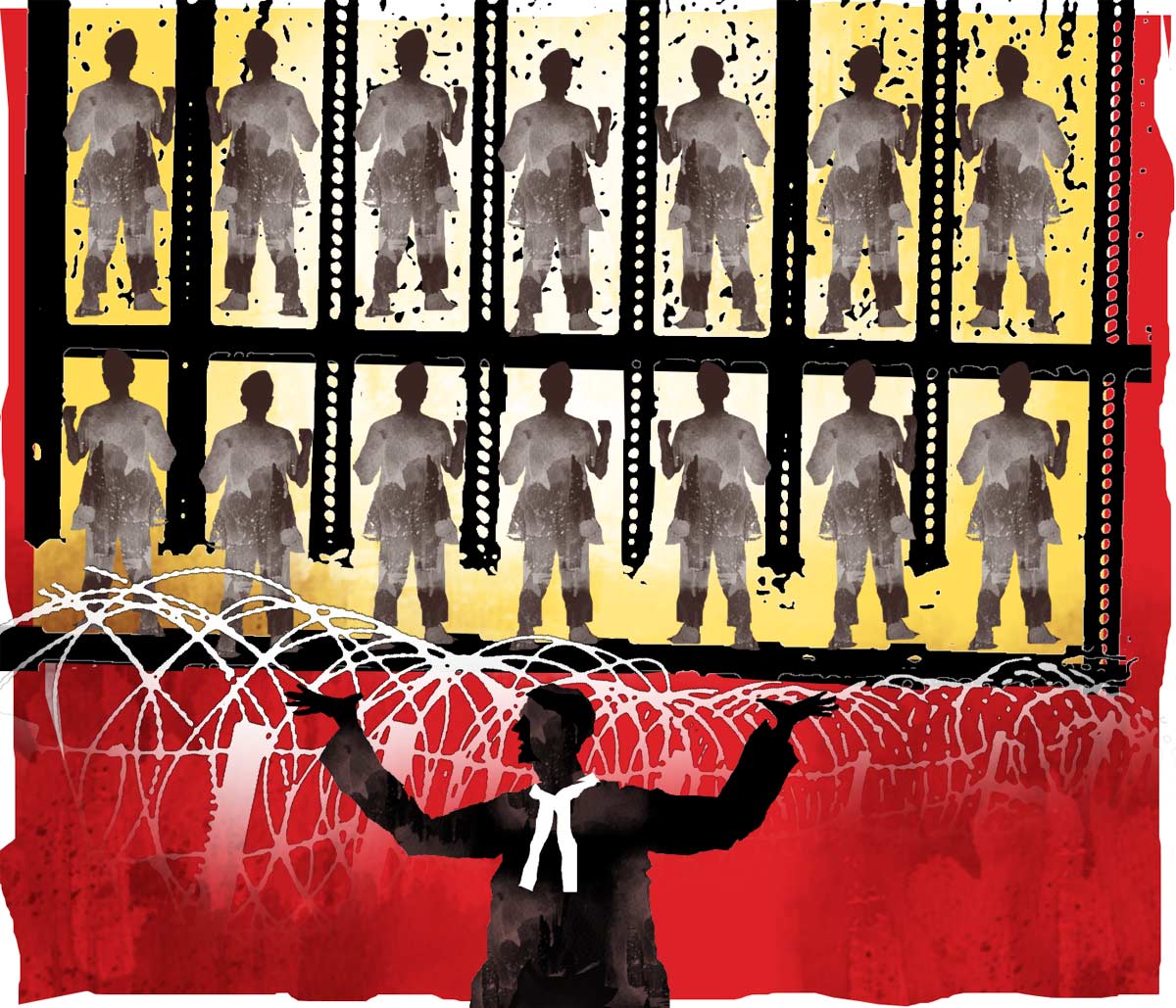Vice President Dhankar's and Law Minister Rijuju's recent interventions have the danger of destabilising the Constitutional equilibrium, cautions N Sathiya Moorthy.

Two episodes in four days and old-timers are asking themselves if it is a return to the pre-Emergency era of a 'committed judiciary', which found its full flow during the Emergency.
The Supreme Court has since injected its own share, with what critics should accept at least as 'partial transparency' in the collegium's choice of high court judges with what the government seems to have concluded as A 'negative report' from the Intelligence Bureau.
Between them, Vice-President Jagdeep Dhankar and Union Law Minister Kiren Rijiju have said or done things that implies that the government wants the higher judiciary of the land, beginning with the Supreme Court under Chief Justice Dr D Y Chandrachud to mend its ways and be helpful to the popularly elected government in the discharge of its electorally mandated policies and programmes, even if the other found them to be inconsistent with the letter and spirit of the laws, starting with the Constitution.
That is what a 'committed judiciary' is all about.
The alternative or the add-on is 'packing' the bench with judges with ideological or personal commitment to the ruling party and leadership.
A competitive judiciary has at times responded with what tantamount to 'judicial over-reach', which is what the collegium publicising the reiterated attestation of the two so-called controversial choice for judgeship in two high courts will be seen as -- and propagated thus.
Forming the list are lawyers Saurabh Kirpal (Delhi high court), and also Somasekhar Sundaresan (Bombay high court) and R John Sathyan (Madras high court), both vetoed by the government for their tweets against the government leadership.
It is true that the collegium was responding to criticism that its decisions lacked transparency and objectivity, but in doing so, it may have violated its own gag on not publicising its conclusions.
Now that it is out in the open, any or all the three can contest the government claims, again in the very same supreme court.
The term 'committed judiciary' has had its origins in the late Mohan Kumaramangalam, who as minister in the Indira Gandhi government, used the term, purportedly in the propagation of their perception of socialism.
'Packing' the bench goes back to the US of the late thirties, when President Franklin Delano Roosevelt did not find the American supreme court supportive of his 'New Deal' to address the fallouts of the 'Great Depression'.
Kumaramangalam's ideology found expression when the Indira Gandhi government first superseded the three senior-most judges to make Justice A N Ray the chief justice.
Likewise, Justice H R Khanna had to make way for Justice M H Beg after he had handed down a strong dissenting judgment in the habeas corpus case, or 'ADM Jabalpur case', in the Emergency era.
That was the case in the which the then attorney general Niren De argued that during the suspension of fundamental rights under the Emergency provisions, the citizen did not have the right even to his life, leave alone liberty, both guaranteed by the Constitution.
There is a perception that such a mindset alone led to the emergency (1975-1977) though Kumaramangalam had died in an air crash in 1973 but with Sanjay Gandhi enforcing it even more crudely.
This sums up the situation of our time and the dichotomy facing the Indian judiciary, otherwise seen as being an independent institution, the mandated watch-dog of the Constitution and democracy in the country.
To be fair to the government of Prime Minister Narendra Modi, it has not superseded any Supreme Court judge in the choice of the CJI, not so far, though it has happened in and to other institutions, including or starting with the armed forces.
In a lesser known episode, Justice S R Sen of the Meghalaya high court made a patently political statement in a judgment on the issuance of domicile certificate, though the government leadership might not have known that such a person existed.
Observed Justice Sen: '...our beloved Prime Minister (Modi) has sought to legislate to grant automatic citizenship to (non-Muslim) religious minorities who have come from Pakistan, Bangladesh and Afghanistan.
'Our political leaders in 1947 were too much in a hurry to get the Independence, thus, creating all the problems of today, and that nobody should try to make India as another Islamic country'.
What more, Justice Sen also directed the assistant solicitor general to hand over his judgment copy to Modi, Home Minister Amit Shah and Law Minister Kiren Rijiju, thankfully without naming them.
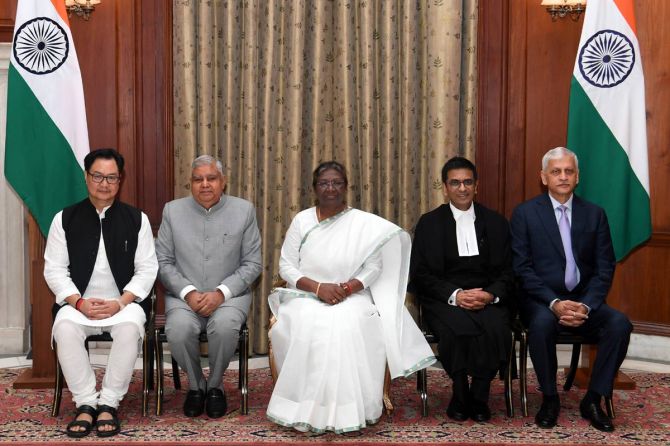
It is in this overall background and emerging eco-system Vice President Dhankar questioning the 'Basic Structure' theory enunciated by the Supreme Court in October 1972 (Kesavananda Bharati vs State of Kerala), and also Minister Rijiju's epistle to Chief Justice Chandrachud need to be viewed.
They are not stand alone instances but independent and successive products of a prevailing eco-system.
In the Kesavananda Bharati case, a 13-judge bench of the Supreme Court held by a wafer-think majority that the Constitution cannot be amended so as to take away what it termed as the 'Basic Structure', but without defining the term.
In doing so, the court ruled that 'judicial review' was a basic structure and every law of Parliament and decision of the Executive would be subject to judicial review, if challenged -- and the court's verdict would hold, independent of other laws that were in place.
As if responding to the vice president at a felicitation function in Mumbai, his native Bar, Chief Justice Chandrachud termed Kesavananda Bharati as a 'ground-breaking' judgment that guides the judges like a North Star in interpreting and implementing the Constitution.
The verdict, according to the Chief Justice, aids in keeping the soul of the Constitution intact even as judges interpret the text of the Constitution with the changing times.
In a way, the Kesavananda verdict only reiterated the Constitutional provision that made 'law declared by the Supreme Court as binding on all courts' in the country (Article 141).
In reality, stand-alone Supreme Court judgments have become the law of the land, without any independent or supporting parliamentary legislation.
Instances and examples galore, like the curtailment of the powers under Article 356 (dissolution of state assemblies; the S R Bommai case, 1994), conferring supervisory powers on the Election Commission, to order transfer or suspension of 'election officials', drafted from the Centre or state governments (T N Seshan case), work-place harassment of women (Vishaka case) and fixed minimum two-year tenure for the CBI director and other similary-placed officials (Vineet Narain case).
The Centre's 2021 amendment to the rule only fixed the maximum period at five years, without reducing the minimum.
Suffice to point out that the Supreme Court's arbitration process and the subsequent verdict flowing in the Ayodhya case derived only from the inherent powers of the court.
If anything, the proceedings had side-stepped the submissions of the appellants and respondents in what really was a property-centric civil suit into a kind of public interest litigation.
In the process, the Supreme Court went beyond the plaint and pleadings to direct the government to build a mosque on a five-acre plot -- a directive promptly accepted by this very government.
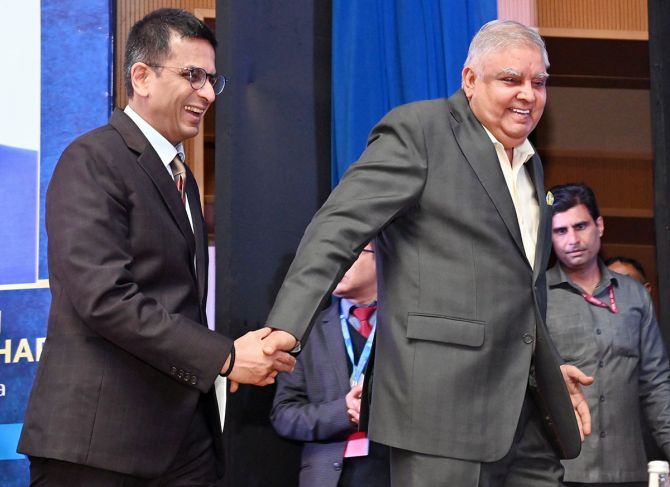
If Dhankar implied that 'judicial review' derived from the Basic Structure theory should not be allowed to impede the sovereignty and powers of Parliament, where the ruling party has an absolute to brutal majority, the reality of his being the Rajya Sabha chairman can encourage -- or, at least not discourage -- fractious debates inside the House that could lower, or seek to lower, the inherent dignity of Constitutional institutions and individuals involved.
Likewise, Rijiju's letter, seeking representation for the government in the selection panel for judges, now called the Supreme Court collegium, and his arguing the case of state governments having a say in the selection of high court judges, is fraught with the equal danger of destabilising the existing scheme and system -- and thus the carefully-crafted and even better-nurtured Constitutional equilibrium.
At stake is the 'independence of the judiciary', as democracy ordains and the Constitution mandates.
This should not not be confused with the American model, where court officials are elected and supreme court judges are nominated directly by the President and publicly vetted by the United States Congress.
Because it was a 'packed bench' with ideology-driven judges, the US supreme court could take back the constitutional protection for abortion earlier awarded under Roe vs Wade.
In contrast, Chief Justice Chandrachud had a point when he explained court arrears as also a product of the Supreme Court not stopping with interpreting the Constitution, as in the US and elsewhere, but also serving as the last refuge of the citizen.

All of it does not mean that the Indian judiciary is without blemishes, or it should not hold a mirror to its face occasionally, without the government of the day having to do so, and in what at times could be a crude way of doing it.
But that is another issue, independent of 'packed judges', as there have been multiple instances where different benches even of the Supreme Dourt giving different interpretations to the same set of legal/Constitutional questions at hand.
It only implies that the Chief Justice's supervisory powers are either not exercised, or not obeyed, or both. Again, there is a long list.
There is also no reaon why the Supreme Court encourages the high courts and subordinate courts to grant adjournments ad nauseum for reasons that are not strictly legal, or even allow lower courts and parties to the case trampling upon the specific directives of the highest court of the land -- all of it impacting on the citizen's basic rights that go beyond even the Fundamental Rights guaranteed under the Constitution.
For instance, in the infamous 'disproportionate assets case' against the late Tamil Nadu chief minister J Jayalalithaa, her defence could manage to drag the trial court hearing for a full decade after the apex court had ordered the trial to be completed within a fixed period.
The fact was that both the Karnataka high court, and equally so the Supreme Court, were hearing and disposing of interlocutory petitions from the accused, including those complaining about the legibility and accuracy of the English translation of the prosecution records that were in Tamil...
More importantly, the Supreme Court may have to reopen its mind to reviewing the quashing of the National Judicial Appointments Commission Act, moved and passed by the incumbent government, which is now seen as hitting back from a position of relative political strength.
The collegium's publication of the justification for wanting to induct three high court judges whom the government finds to be an unpleasant task or worse, may have opened a Pandora's Box.
With all these, both sides may have crossed the Rubicon.
Wise counsel should prevail, and one mutually accommodating way, may be for the President to intervene, formally or figuratively, and seek the Supreme Court's 'opinion' in matters of judicial appointments, and collegium members stay away from that bench, as they now have a 'conflict of interest'.
After all, five collegium member-judges do not constitute a majority and maybe the Chief Justice as the 'roster judge' could refer such a matter to a larger bench of 13 or even 15 judges or more -- and all sides should abide by the verdict, which could go also into related matters of basic structure, judicial review and appointments.
N Sathiya Moorthy, veteran journalist and author, is a Chennai-based policy analyst and political commentator
Feature Presentation: Aslam Hunani/Rediff.com

